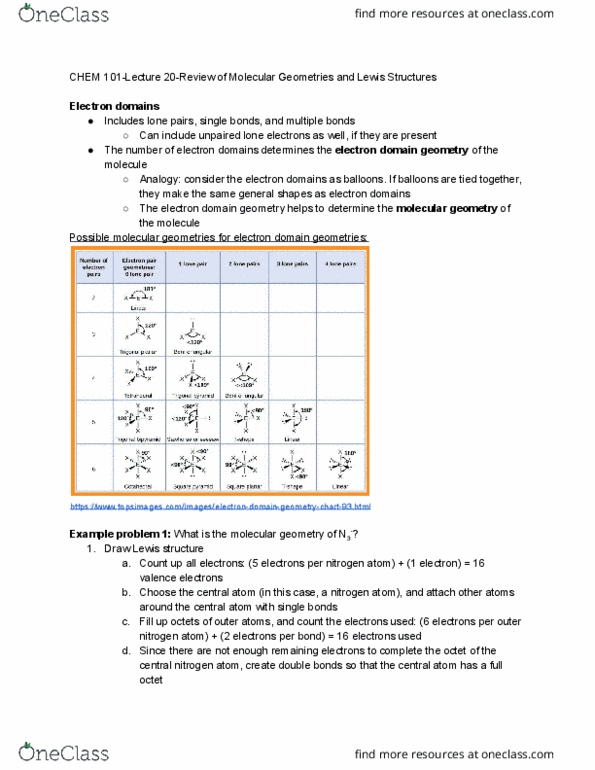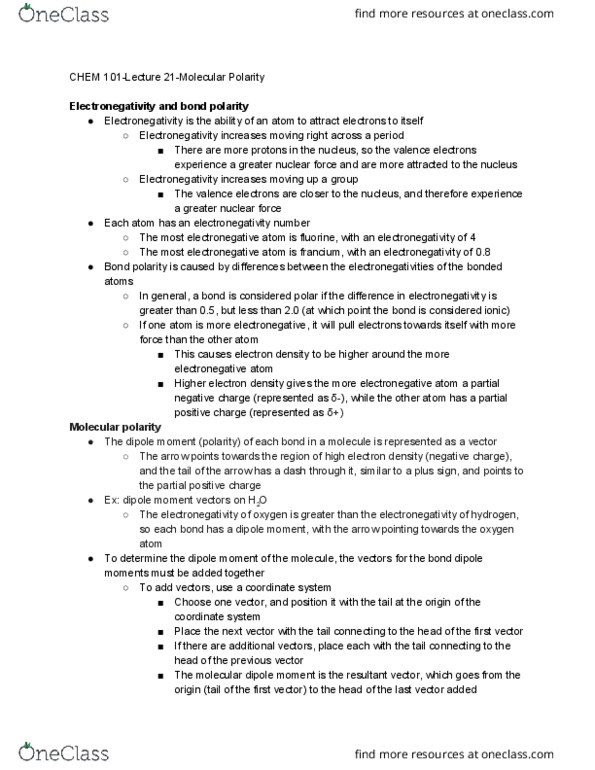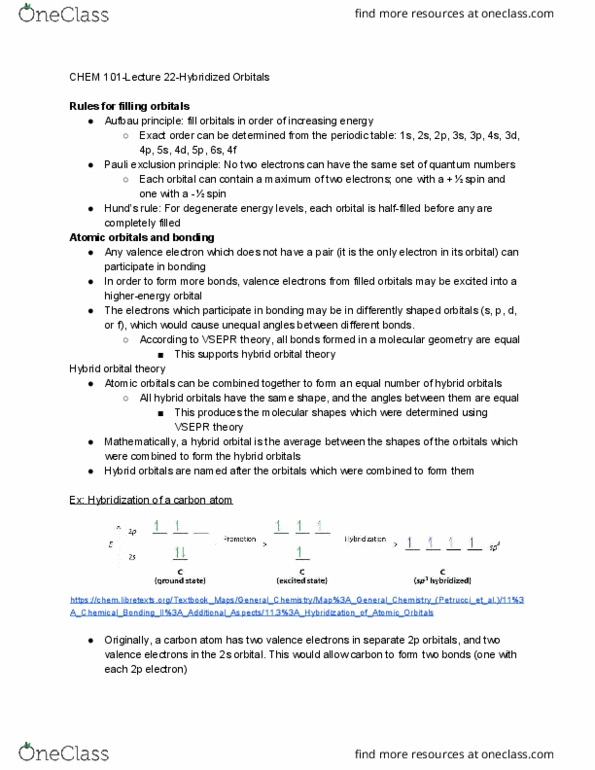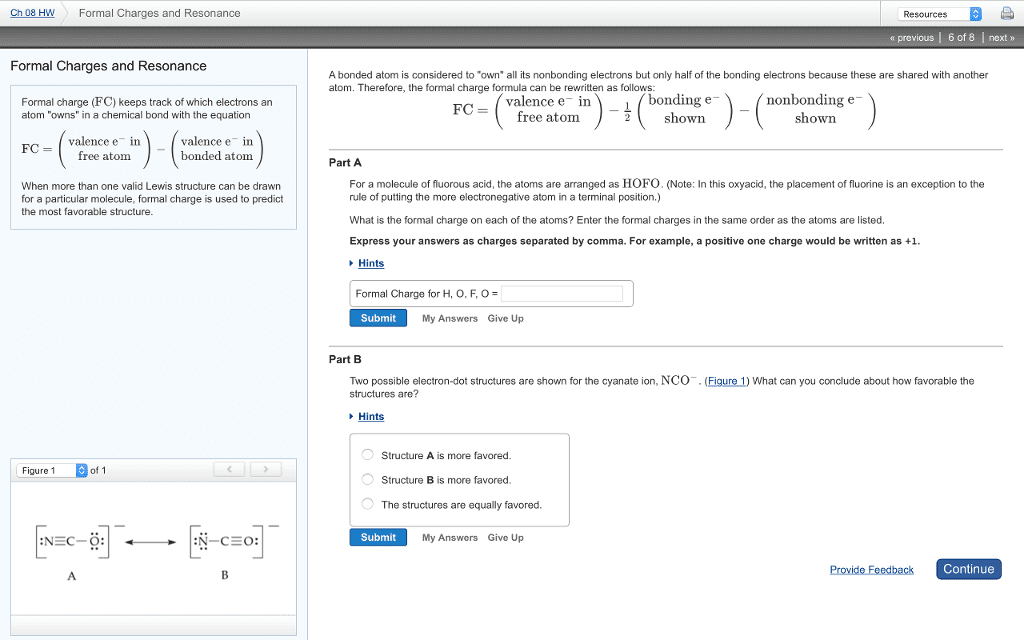Please answer these for me im totally confused
001 10.0 points
Consider the atoms
A) nitrogen B) bismuth C) arsenic
Arrange them in order of increasing ï¬rst
ionization energy.
1. A, C, B
2. B, A, C
3. C, B, A
4. B, C, A
5. A, B, C
6. C, A, B
002 10.0 points
Which of the following is a measure of the
tendency of an atom in a molecule to attract
electrons to itself ?
1. L nonbonding
2. polar
3. electronegativity
4. ionization
003 10.0 points
Which ion has the larger radius?
1. Unable to determine
2. Both have same radius.
3. Sn
2+
4. Sn
4+
004 10.0 points
Which of the following statements is true?
1. Electron aï¬nity is a measure of the
amount of energy needed to remove an electron from an atom.
2. As electron aï¬nity increases (becomes
increasingly negative), electronegativity decreases.
3. Electronegativity is a measure of the tendency of an atom tolose electrons.
4. When ionization energy increases, electronegativityincreases.
5. Ionic radii are always larger than atomic
radii for the same element.
005 10.0 points
Which of the following is a true statement?
1. There is no relationship between atomic
size and ionization energy.
2. Ionization energy increases as electronegativitydecreases.
3. Electronegativity increases as electron
aï¬nity decreases (gets more positive).
4. None of these
5. Ionization energy increases as atomic size
decreases.
006 10.0 points
Which of the following correctly rationalizes
the increase in atomic radii down and to the
left on the periodic table, based on what we
discussed in class?
1. None of these. Atomic radii increase up
and to the right.
2. Because the elements are easier to ionize, they have a largerelectronegativity, and
therefore their electron aï¬nity is not suï¬-
cient to reduce atomic radii.penwell (blp865) â HW 12 PeriodicTrends â thompson â (991918292) 2
3. Larger elements have an increasing proportion of d and forbitals, which are intrinsically larger than all of the s and porbitals.
4. As you move to the left across a period,
decreasing ENC means the outer electrons
are less tightly held and can move further
from the nucleus. As you move down a group,
the electrons occupy orbitals that are further
from the nucleus.
5. The elements are simply larger due to
more protons and neutrons.
6. The periodic table was set up to group
atoms by size to facilitate comparisons.
007 10.0 points
In a series of species with the same total set
of electrons present, one observes that
1. the radii would increase as the atomic
number increases.
2. the radii would decrease as the atomic
number increases.
3. the radii would decrease as the number of
electrons increases.
4. all have the same radius.
5. the radii would increase as the number of
electrons increases.
008 10.0 points
The ions Na
+
, F
â
, and O
2â
each have ten
electrons. What would be the order of the
sizes of these three ions?
1. Na
+
is smaller than O
2â
which is smaller
than F
â
.
2. O
2â
is smaller than Na
+
which is smaller
than F
â
.
3. F
â
is smaller than O
2â
which is smaller
than Na
+
.
4. F
â
is smaller than Na
+
which is smaller
than O
2â
.
5. Na
+
is smaller than F
â
which is smaller
than O
2â
.
009 10.0 points
Which of the following atoms has the largest
radius?
1. K
2. Mg
3. Li
4. Br
5. Si
010 10.0 points
Why is it harder to remove an electron from
ï¬uorine than from carbon, or, to put it another way, why are thevalence electrons of
ï¬uorine more strongly bound than those of
carbon?
1. The valence electrons of both ï¬uorine and
carbon are found at about the same distance
from their respective nuclei but the greater
positive charge of the ï¬uorine nucleus attracts
its valence electrons more strongly.
2. Fluorine has more valence elctrons than
does carbon.
3. Carbon has a lower atomic mass than
does ï¬uorine.
4. Fluorine has a nearly ï¬lled octet, which
is always more stable than a partially ï¬lled
octet.
5. The statement is false; it takes very nearly
the same energy to remove an electron from
(ionize) both elements.
011 10.0 points
In general, ionization energy tends to increasepenwell (blp865) âHW 12 Periodic Trends â thompson â (991918292) 3
in the periodic table
1. from bottom to top and from right to
left.
2. in no regular trend.
3. from bottom to top and from left to
right.
4. from top to bottom and from right to
left.
5. from top to bottom and from left to
right.
012 10.0 points
Consider the most stable ions which are
formed by the elements Cs, Ba, Te and I.
Which element will form the ion with the
largest radius? (Hint: the ions will be isoelectronic.)
1. Ba
2. Te
3. Cs
4. I
013 10.0 points
Which of the following has the largest radius?
1. S
2â
2. K
+
3. Cl
4. Cl
â
5. S
014 10.0 points
What is the order of decreasing ionization
energy?
1. tellurium, selenium, oxygen
2. oxygen, selenium, tellurium
3. selenium, oxygen, tellurium
4. selenium, tellurium, oxygen
5. oxygen, tellurium, selenium
6. tellurium, oxygen, selenium
015 10.0 points
Which atom is smaller?
1. Unable to determine
2. bromine
3. iodine
4. They have the same size.
016 10.0 points
Rank the following species from smallest to
largest atomic radius: K, Mg, Rb, Ca.
1. Rb < K < Ca < Mg
2. Mg < Ca < K < Rb
3. Mg < Ca < Rb < K
4. Mg < Rb < K < Ca
5. Mg < K < Ca < Rb
017 10.0 points
Francium (atomic number 87) would be expected to have a (large,small) ï¬rst ionization
potential and a (large, small) electronegativity.
1. large; large
2. small; small
3. large; small
4. small; largepenwell (blp865) â HW 12 Periodic Trends â thompsonâ (991918292) 4
018 10.0 points
Consider the following ground-state electronic
conï¬gurations. Which atom has both the
highest ï¬rst ionization energy and the highest
electron aï¬nity?
1. [Ne] 3s
2
3p
4
2. [Ne] 3s
2
3p
5
3. [Ne] 3s
2
3p
1
4. [Ne] 3s
2
3p
3
019 10.0 points
The energy needed to remove electrons from
an atom is called
1. bonding energy.
2. ionization energy.
3. valence energy.
4. network energy.
020 10.0 points
Rank the following atoms and ions
Li
+
, Be
2+
, He, H
â
, B
3+
in order of decreasing size.
1. B
3+
, Be
2+
, Li
+
, He, H
â
2. B
3+
, Be
2+
, He, Li
+
, H
â
3. H
â
, Li
+
, He, Be
2+
, B
3+
4. He, H
â
, Li
+
, Be
2+
, B
3+
5. H
â
, He, Li
+
, Be
2+
, B
3+
021 10.0 points
Rank the following in terms of decreasing
ionic radii.
1. F
â
, O
2â
, N
3â
, Na
+
, Mg
2+
2. Na
+
, Mg
2+
, O
2â
, N
3â
, F
â
3. N
3â
, O
2â
, F
â
, Na
+
, Mg
2+
4. Mg
2+
, Na
+
, F
â
, O
2â
, N
3â
5. Na
+
, Mg
2+
, N
3â
, O
2â
, F
â
022 10.0 points
What is the order of decreasing atomic radius?
1. chromium, titanium, cobalt
2. titanium, cobalt, chromium
3. cobalt, titanium, chromium
4. titanium, chromium, cobalt
5. cobalt, chromium, titanium
6. chromium, cobalt, titanium
023 10.0 points
Atoms with loosely held valence electrons
have
1. high ionization energy and high electron
aï¬nity.
2. low ionization energy and low electron
aï¬nity.
3. low ionization energy and high electron
aï¬nity.
4. high ionization energy and low electron
aï¬nity.





